If you’ve done any reading on the subject of permaculture, then you have for sure heard of comfrey. This plant has become the permaculturists darling for good reason, as it has a multitude of benefits including, but not limited to, natural fertilizer, dynamic accumulator, living mulch, companion plant, compost activator, and numerous medicinal uses. Unfortunately it has also been maligned in recent years, namely by the FDA, and wrongfully so in my opinion.
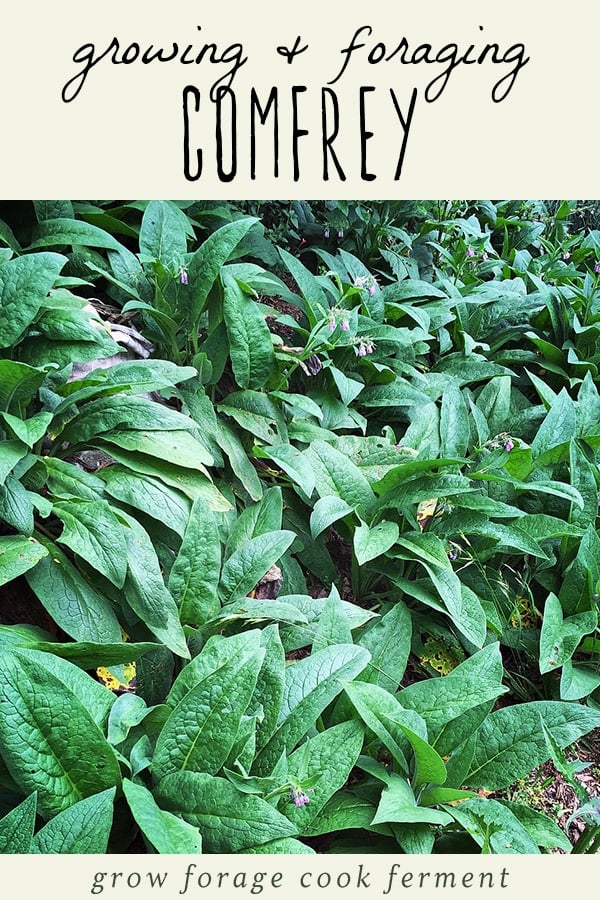
Want to save this post for later?
Wildcrafting Weeds
If you want to learn more about the edible and medicinal weeds that surround us and how to use them, check out my eBook: Wildcrafting Weeds: 20 Easy to Forage Edible and Medicinal Plants (that might be growing in your backyard)!
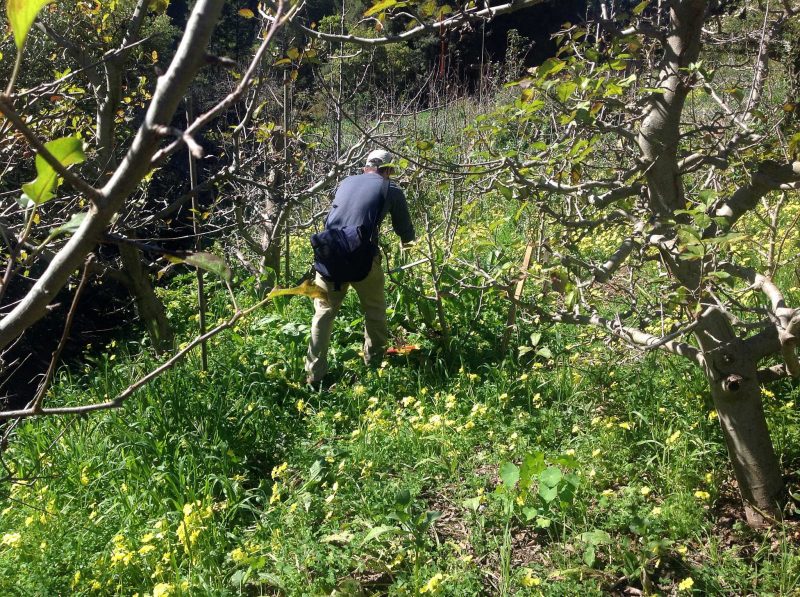
Foraging for Comfrey
Joel and I “foraged” for comfrey and its roots when we were at the UC Santa Cruz Alan Chadwick Garden. We asked one of the employees in the garden if we could take some and she told us to take it all! Of course we didn’t take all of it, but the reason she said that is because it tends to spread very quickly and easily. It is not native to the United States and thus is not really a traditional plant for foragers here, but because it spreads so rapidly after it’s planted, chances are you can probably find it out in the wild somewhere.
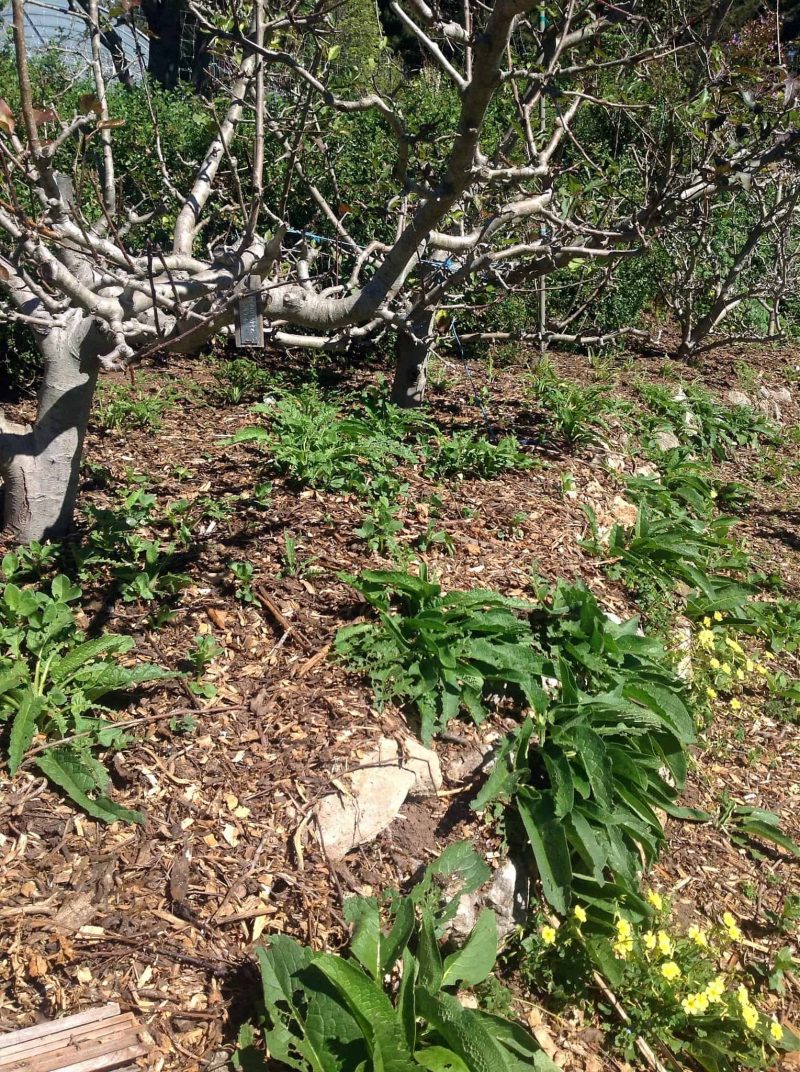
Uses of Comfrey
Here it is growing around fruit trees. It is often used as a component of a guild, which is a group of plants arranged to mutually benefit each other. Comfrey has a deep taproot and is a dynamic accumulator, which means that it brings up important nutrients from the soil that other plants benefit from, thus making it a great companion plant.
Here is that same patch of comfrey, one year later. Look at how much it has spread!
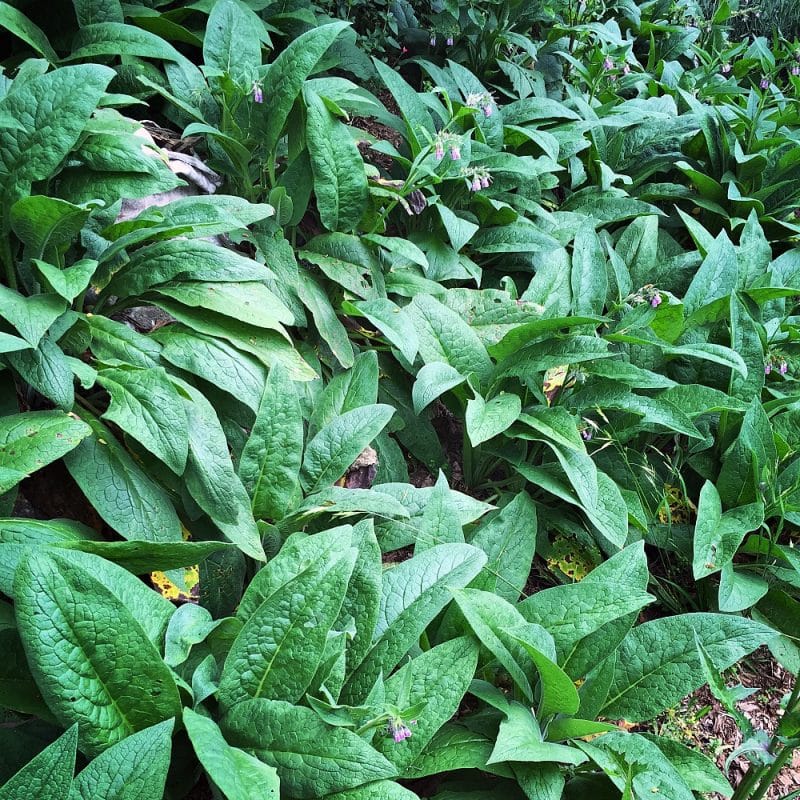
Comfrey is also great for mulching, especially in the chop and drop form, and for compost. It is especially good when grown with fava beans or other cover crop nitrogen fixers. Once these plants get to a certain size they can be chopped and left in place as mulch and compost. You can also make a wonderful compost tea out of comfrey leaves to use on your garden plants.

Comfrey has a nice flower that attracts bees and other beneficial insects. The flowers are generally white, pink, or purple, and they hang down from a central stem.
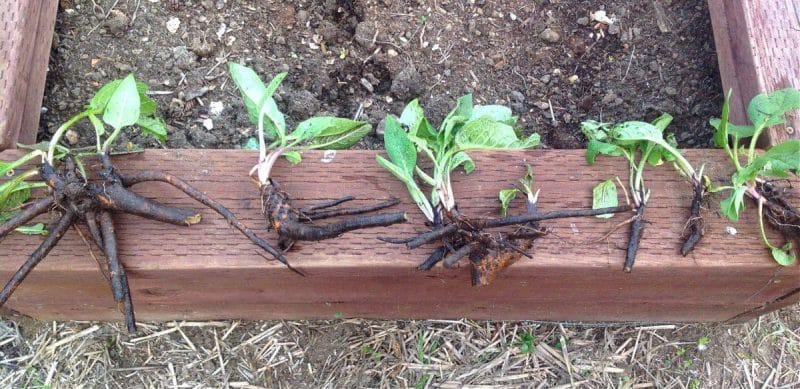
How to Grow Comfrey
Joel dug up a bunch of comfrey roots for propagation as they grow very easily from root cuttings. He cut off all of the green leafy matter and planted the bare roots in pots. We are not 100% certain of the variety as there are two types that are commonly grown, Russian or Common. The Russian variety, however, is sterile and cannot reseed itself, so can only be propagated by root division or cuttings. Our guess is that this is Common Comfrey (Symphytum officinale).
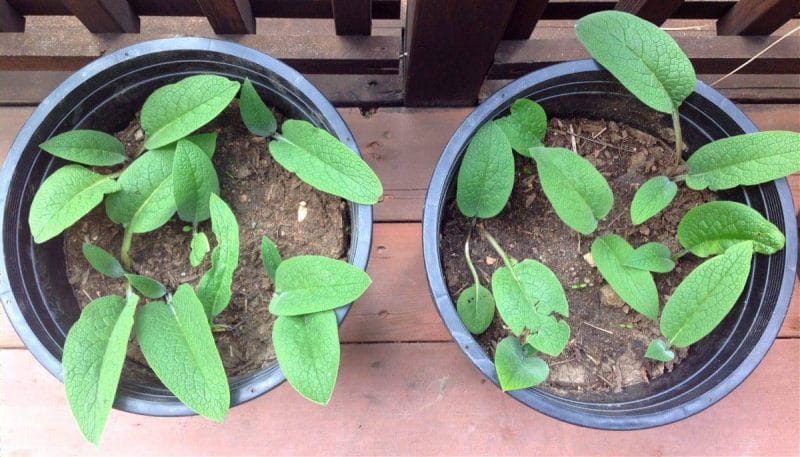
It didn’t take more than a couple of weeks to get some nice leafy growth.
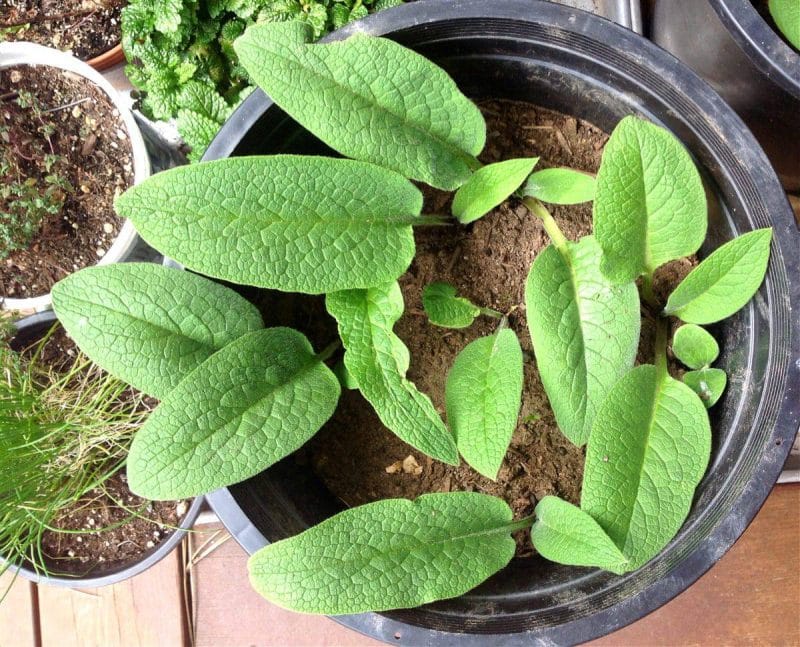
Then they started growing so fast it seemed like we could actually watch them get bigger!
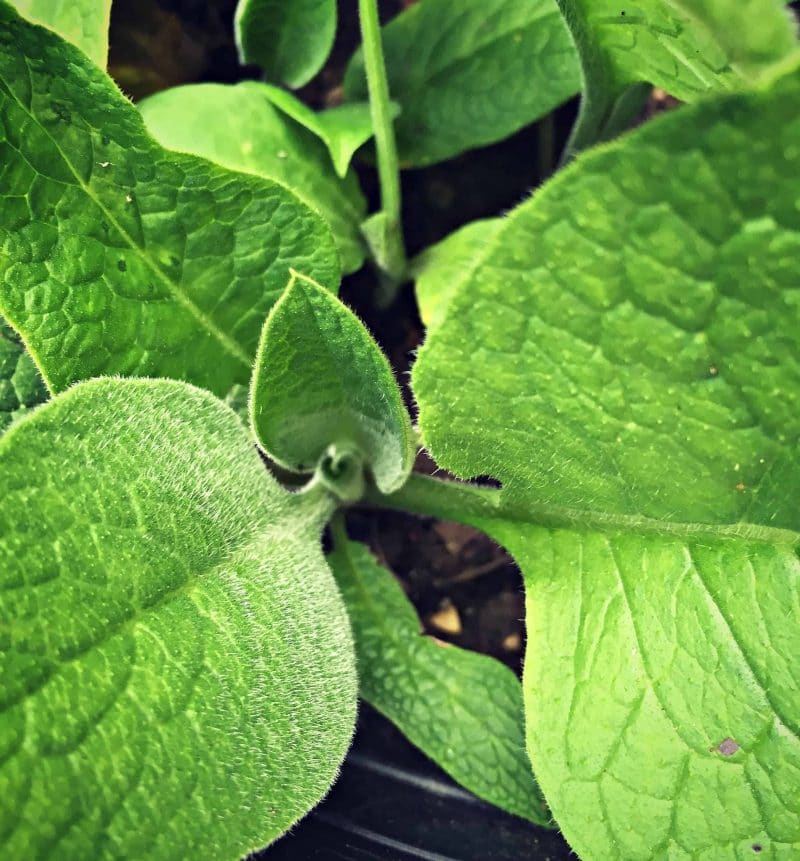
Comfrey also has a multitude of medicinal benefits. This is where the FDA claims have been a little bit overblown. It has been used for ages as a wonderful medicine and Common Comfrey (Symphytum officinale) is quite harmless. It is a powerful wound healer and is often used in a basic Comfrey Salve or other herbal salves and creams alongside other herbs such as plantain, yarrow, calendula, and St. John’s Wort. It is also well known to help heal broken bones, hence the nickname “knitbone” that it has acquired. As with any herbs, use with caution especially when taken internally, but as long as you’re just using it for short periods of time you really should be just fine.
If you don’t have any comfrey around, but still would like to use it, buy comfrey root or comfrey leaf from Mountain Rose Herbs (my favorite source of high quality, organic dried herbs).
Here are some great posts about Comfrey and its use:
- What is Comfrey and How to Grow it from Tenth Acre Farm
- Does Comfrey Really Improve the Soil? from Tenth Acre Farm
- Comfrey, Symphytum officinale from Common Sense Homesteading
- Growing Comfrey: A Natural Mulch Plant from Untrained Housewife
- In the Garden ~ Growing Comfrey from Schneiderpeeps
- Comfrey, It’s Culture and Uses by North Country Farmer
- Comfrey Salve from Grow, Forage, Cook, Ferment
- Herbal Diaper Rash Salve from Grow, Forage, Cook, Ferment
- Comfrey Fertilizer Tea from Grow, Forage, Cook, Ferment
And here are some more specifically about Comfrey’s medicinal value:
- Comfrey Uses and Remedies from The Herbal Academy
- DIY Herbal Healing Balm from Learning and Yearning
- Herbal “Heal All” Salve from One Ash Farm and Dairy
- Natural Dandruff Remedy from Simple Life Mom
- 3 Natural Ways to Help a Lamb with a Broken Leg from Joybilee Farm
The more you read about it the more you will want to be growing and foraging for comfrey! It has so many uses, it really is a wonder plant.

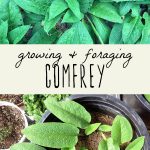

Hello Colleen
When I forage comfrey leaves and dry them in the dark, some keep green but a lot of them turn dark, like a kind of rusty colour.
Is it possible to avoid that?
Thank you.
Foragers beware. People have died by mistaking foxglove for comfrey. The leaves of foxglove, especially when young, resemble comfrey. Always know what you’re picking, preferably watching the plant through a season of growth. The flowers of comfrey and foxglove are quite different and allow even a neophyte forager to distinguish the two. Better safe than sorry.
I can’t find an answer anywhere specific to my question- Will these resilient roots, will it damage the foundation of a house?
My gypsy grandmother grew it close to the back porch for 70 plus years. It never damaged the foundation of her house.
It’s also very good for momma rabbits!
Found lots where I live today. Thrilled ! I’d be happy to try an get some seeds for a couple people,when it’s time.
I would love some if you have any more or next years seed crop.
Do you still have Comfrey? I know it’s been a while since you wrote that you found some growing. I would love to have the kind that resends itself. Let me know and I’ll send postage. Thanks!
How about in New Zealand
Eric are you asking how it grows?I have it in a few places and use it for health and also composting.Once you have it its always there.You can buy seeds at Kings online
We have a big patch of comfrey but I would like to know how to tell which I have. Are there any other differences between the two other than what you mentioned?
If you plant it at your home, plant it where you will never have to move it. Digging it up and discarding it will not work. It will grow where you throw!! I have many uses for Comfrey and I dry a large amount each year. I make salves and poultices from the leaves. It is invasive so be considerate where you plant it. A great medicinal herb!
They only way to get rid of it is to mulch it with black plastic and concrete blocks to starve it out. I left it a full year to be sure it’s gone from that spot.
My comfrey looks like yours in the pot. When should I transplant it around my Apple trees? When can I cut it to use for a poltice? Thanks
Comfrey is very vigorous and forgiving, you could transplant or cut off the leaves for use at any time.
Where I agree that comfrey has many benefits, and I agree that the FDA often oversteps, I would recognize that liver failure sucks. So if you or someone you are thinking of treating has a compromised liver, sugar addiction or other such challenges, use with extreme caution.
Fantastic!!
Really interesting, Colleen! We will have to look for it around our area. Have u ever seen it?
I don’t remember seeing it anywhere by your house, but then again I wasn’t really looking specifically for it.
I’ve been scouring my area looking for some wild comfrey, but I have not found anything yet. I’ll see something at a distance, but when I get closer i find that it doesn’t have the dinosaur-scale patterned leaves like you show in the picture. I’ll keep my eyes open though. Then I can plant it and have it around for ever and ever.
We have lots of comfry in our fields
We don’t use it
Colleen I an use it for sooo many things!!!!1